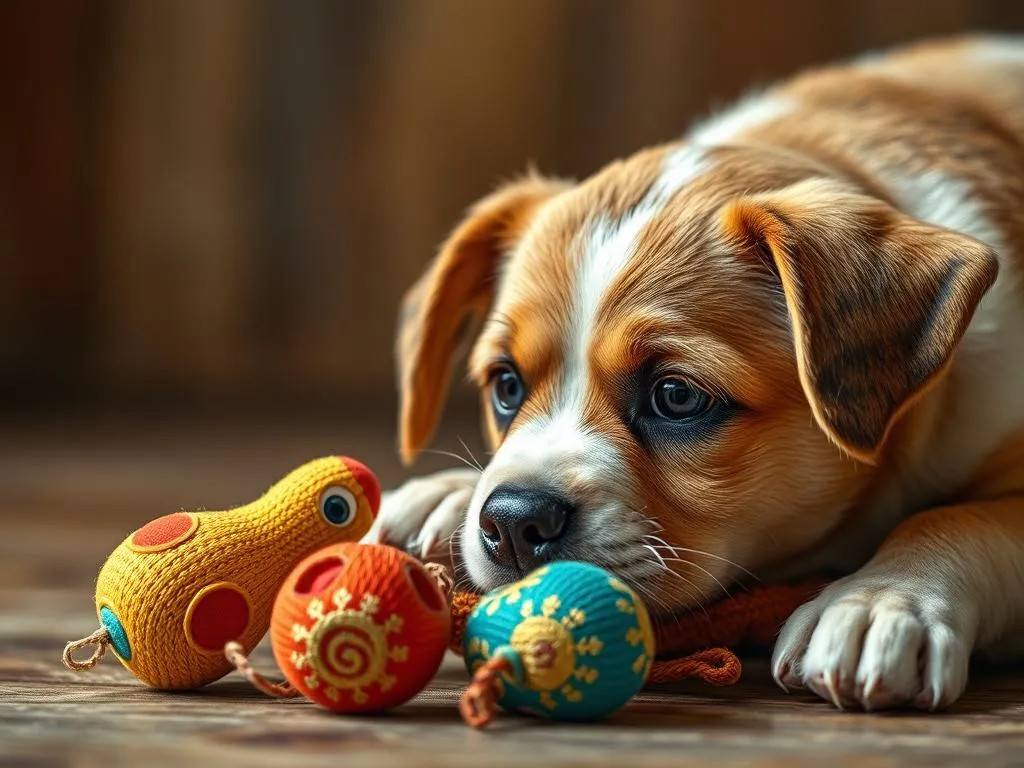
Puppy toys play a crucial role in a puppy’s development and overall well-being. From providing mental stimulation to encouraging physical exercise, toys are essential for a young canine’s growth. Engaging with toys not only keeps puppies entertained but also helps them learn and socialize, laying the groundwork for healthy behaviors as they grow. In this article, we’ll explore the best puppy toys available on the market and offer guidance to pet owners on selecting the right toys for their furry friends.
Understanding Puppy Development
Importance of Play in Early Development
Play is fundamental to the cognitive and physical development of puppies. It fosters problem-solving skills, enhances motor skills, and encourages social interaction. Through play, puppies learn how to navigate their environment, understand boundaries, and develop healthy social skills, which are crucial for their future interactions with humans and other animals.
Different Stages of Puppy Development
Puppies go through several developmental stages, including:
- Neonatal Stage (0-2 weeks): Puppies are entirely dependent on their mother and do not engage in play.
- Transitional Stage (2-4 weeks): Puppies begin to open their eyes and ears, starting to explore their environment.
- Socialization Stage (4-12 weeks): This is the critical period for socialization, where puppies should be exposed to various stimuli. Toys can help facilitate this process.
As puppies grow, their preferences for toys can change. Younger puppies may prefer soft toys, while older pups might gravitate towards more interactive or durable options.
Types of Puppy Toys
Chew Toys
Chew toys are vital for teething puppies. They help alleviate discomfort associated with growing teeth and promote healthy chewing habits. Recommended materials include rubber and nylon, which are durable and safe. Some popular chew toys include:
- KONG Classic: A durable rubber toy that can be filled with treats.
- Nylabone DuraChew: Made of tough nylon, perfect for aggressive chewers.
- Benebone Wishbone: A flavored chew that keeps puppies entertained for hours.
Interactive Toys
Interactive toys are designed to stimulate a puppy’s mind and encourage problem-solving. They often involve puzzles or treat dispensers that keep puppies engaged and mentally active. Benefits include enhanced cognitive skills and reduced boredom. Some popular interactive toys are:
- Outward Hound Hide-A-Squirrel Puzzle Toy: A fun, interactive plush toy where puppies can remove squeaky squirrels from their hiding spots.
- PetSafe Busy Buddy Twist ‘n Treat: A customizable treat-dispensing toy that can be adjusted to vary the level of challenge.
Fetch Toys
Fetch toys are essential for exercise and can be a great way for puppies to burn off energy. Common fetch toys include balls and frisbees. When selecting fetch toys, look for durability to withstand vigorous play. Recommendations include:
- Chuckit! Ultra Ball: A high-bouncing, durable ball that is perfect for fetch games.
- KONG Flyer: A soft frisbee that is gentle on a puppy’s mouth while still being tough.
Plush Toys
Plush toys provide comfort and emotional support to puppies. They can serve as companions during stressful times, such as when a puppy is left alone. However, safety is essential; avoid toys with small parts that could be swallowed. Popular plush toys include:
- ZippyPaws Skinny Peltz: A stuffing-free plush toy that comes in various animal designs.
- Mammoth Flossy Chews: A plush toy with a rope that encourages healthy chewing.
Tug Toys
Tug toys are great for bonding and physical exercise. They allow puppies to engage in tug-of-war games with their owners, which can strengthen the bond between them. Safe materials for tug toys include cotton and durable rubber. Recommended tug toys are:
- PetFusion Tug-of-War Toy: Made of durable material, perfect for interactive play.
- Mammoth Flossy Chews Tug Rope: A soft yet strong rope designed for tugging.
How to Choose the Best Puppy Toys
Consider the Puppy’s Size and Breed
When selecting toys, consider your puppy’s size and breed, as these factors will influence toy choice. Smaller breeds may require toys that are appropriately sized to avoid choking hazards, while larger breeds will need more durable options. Always check the manufacturer’s recommendations for size.
Assessing the Puppy’s Play Style
Puppies have different play styles, including:
- Chewers: Puppies that enjoy chewing may benefit from durable chew toys.
- Fetchers: If your puppy loves to chase, fetch toys are ideal.
- Tuggers: For puppies that enjoy tugging games, strong tug toys will enhance playtime.
Understanding your puppy’s preferences will guide you in selecting toys that will keep them engaged.
Safety Considerations
Safety should always be a top priority when choosing toys for your puppy. Look for toys made from non-toxic materials and ensure that they do not contain small parts that could pose choking hazards. Regularly inspect toys for wear and tear, and replace them when necessary.
Top 10 Best Puppy Toys
Overview of Criteria for Selection
The following list of the best puppy toys is based on criteria like durability, safety, and engagement. Each toy is selected to meet the varied needs of puppies at different stages of development.
List of Top 10 Toys
- KONG Classic
- Description: Durable rubber toy that can be filled with treats or peanut butter.
- Key Features: Strong, dishwasher safe, and perfect for teething.
- Price Range: $10 – $25
-
Where to Buy: Pet stores and online retailers.
-
Nylabone DuraChew
- Description: Tough nylon chew toy for aggressive chewers.
- Key Features: Variety of flavors and shapes.
- Price Range: $5 – $15
-
Where to Buy: Pet stores and online retailers.
-
Outward Hound Hide-A-Squirrel Puzzle Toy
- Description: Interactive toy that challenges puppies to find squeaky squirrels.
- Key Features: Encourages problem-solving and mental stimulation.
- Price Range: $10 – $20
-
Where to Buy: Pet stores and online retailers.
-
Chuckit! Ultra Ball
- Description: High-bouncing ball ideal for fetch games.
- Key Features: Durable and floats on water.
- Price Range: $5 – $15
-
Where to Buy: Pet stores and online retailers.
-
ZippyPaws Skinny Peltz
- Description: Stuffing-free plush toy for soft play.
- Key Features: Squeaky and gentle on teeth.
- Price Range: $10 – $15
-
Where to Buy: Pet stores and online retailers.
-
PetSafe Busy Buddy Twist ‘n Treat
- Description: Adjustable treat-dispensing toy that keeps puppies engaged.
- Key Features: Customizable difficulty level.
- Price Range: $10 – $20
-
Where to Buy: Pet stores and online retailers.
-
KONG Flyer
- Description: Soft frisbee for gentle play.
- Key Features: Durable and safe for puppies.
- Price Range: $8 – $15
-
Where to Buy: Pet stores and online retailers.
-
Mammoth Flossy Chews Tug Rope
- Description: Strong tie-dye rope for tugging.
- Key Features: Promotes dental health while playing.
- Price Range: $6 – $12
-
Where to Buy: Pet stores and online retailers.
-
Benebone Wishbone
- Description: Flavored chew toy in a wishbone shape.
- Key Features: Easy for puppies to hold and chew.
- Price Range: $8 – $15
-
Where to Buy: Pet stores and online retailers.
-
Mammoth Flossy Chews
- Description: Plush toy with a rope, perfect for tugging.
- Key Features: Soft and durable, ideal for gentle play.
- Price Range: $10 – $20
- Where to Buy: Pet stores and online retailers.
Benefits of Regularly Updating Toys
Preventing Boredom
Puppies can easily become bored with their toys, leading to destructive behaviors. By rotating toys regularly, you can keep your puppy engaged and excited about playtime. Introducing new toys can rekindle their interest and provide fresh challenges.
Supporting Development
Different toys can support various aspects of a puppy’s growth. For example, chew toys promote dental health, while interactive toys encourage cognitive development. Ensuring a diverse range of toys can contribute to a well-rounded development during the critical growth stages.
Safety and Hygiene
Regularly replacing worn-out toys is essential for maintaining safety and hygiene. Over time, toys can accumulate dirt and bacteria or become unsafe due to wear and tear. Regular inspections and replacements help to provide a safe and healthy play environment for your puppy.
FAQs about Puppy Toys
How many toys should I have for my puppy?
A good rule of thumb is to have at least 3-5 different types of toys available. This variety allows your puppy to engage in different types of play and keeps them mentally stimulated.
Can my puppy have too many toys?
While having a variety of toys is beneficial, too many can lead to overwhelming choices and potential clutter. It’s best to rotate toys and keep a manageable selection available at any given time.
When should I start introducing toys?
You can start introducing toys to your puppy as early as 8 weeks old. Focus on soft toys that are easy for them to grasp and chew on safely.
How do I clean my puppy’s toys?
Cleaning methods depend on the toy material. Many rubber and nylon toys can be washed in the dishwasher or with soap and water. Plush toys may be machine washable, but check the label for specific instructions.
What should I do if my puppy destroys a toy?
If your puppy destroys a toy, safely dispose of any broken pieces to prevent choking hazards. Consider selecting more durable toys for aggressive chewers in the future.
Conclusion
Choosing the right toys for your puppy is essential for their physical and mental health. Engaging with toys provides numerous benefits, from promoting cognitive development to encouraging socialization and exercise. By considering your puppy’s unique needs and preferences, you can select the best puppy toys that will enrich their playtime and support their growth. Explore the recommended toys and make informed decisions that will contribute to your puppy’s happiness and well-being.









